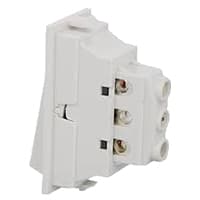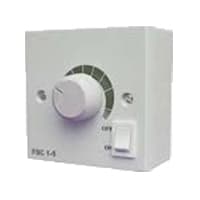Single Phase House Wiring Diagram:
This diagram shows how to make a single-phase house wiring diagram. In this circuit diagram, we use a DP MCB ( Double Pole Miniature Circuit Breaker ), 4 switches, 2 lights, a ceiling fan, and a fan regulator. Here we first input power to DP MCB then from DP MCB to input phase wire to switches and fan regulator, then from the regulator to fan, and power from switches to lights. Now, this circuit is ready for use. If your want to check our youtube video please check our post below link for more information.
Advertisements
Components needed For this Project:
You can get the components from any of the sites below:
- DP MCB 16A [See Buy Click Amazon]
- SPST Switch [See Buy Click Amazon]
- Fan Regulator [See Buy Click Amazon]
- Ceiling Fan 56-Inch [See Buy Click Amazon]
- CFL Light [See Buy Click Amazon]
*Please note: These are affiliate links. I may make a commission if you buy the components through these links. I would appreciate your support in this way!
Advertisements
Components used to make the Single Phase House Wiring:
DP MCB In 2 Pole MCB, switching & protection is affected in phases and the neutral. A Double Pole or DP Switch is a Switch that Controls 2 Circuits at the same time. In terms of Residential Switching, this Normally means it Switches the live and Neutral at the same time. In Layperson Terms, Double Pole switches or DP Switches are Exclusively Designed to Control 2 Different Electrical Circuits at the same time, which allows the Appliances to Isolate safely and reliably. Fan or light Combinations and Medical Equipment are some of the many applications for DP Electrical Switches and Electrical components.
02. Switch:
The 2-Way Switch has a wire connection system. It is a type of switch that has three wire connections. And it really has no off or on. Both sides can be turned on or off depending on how you connect one to the other. The connection of the two-way switch is different. If you use it as a changer, then put the load in the middle one and two separate lines in the upper and lower ones. The two-way switch is a type of multiway switch. Multiway switches have more points and can be controlled in multiple ways simultaneously.
A Fan Speed Controller Controls The Voltage Across the Fan and Therefore Indirectly Controls its speed 220v AC line. A ceiling Fan Speed Regulator Actually Measures and Regulates the Speed of the Fan Using its Tachometer. Fan Speed is Controlled with Thyristor or Transformer Speed Controllers for Ceiling fans, and table fans. the fan is Controlled by a Capacitor, and the Voltage across the fan Determines the fan speed. A Speed Control loop Can be Implemented That is Independent of Manufacturing Variances and Wear on The Fan control system.
04. Ceiling Fan:
A Ceiling Fan is a fan Mounted on the Ceiling of a Room or space, Usually, Electrically Powered, That Uses hub-mounted Rotating Blades to Circulate air flow. They cool people effectively by increasing speed. It Doesn not Cool the Air Temperature — we Feel Cooler Because the Fan Moves the Air Around Us, a Process Called Evaporative Cooling. Evaporative Cooling Works like this: A cold day will feel Even Cooler if There is a Breeze Because of the wind Chill Factor.
CFL stands for Compact Fluorescent Lamp which is an improved version of tube lights of earlier days. Like tube lights, it is a vacuum glass tube with fluorescent powder coating which is not as long and straight as tube lights but curved/twisted compact, or small in size. Like a tube light, it has electrodes or filaments at both ends. But in this case, instead of a choke, there is an electronic circuit that drives the Compact Fluorescent Lamp. Because the red wave is less in the light of the Tubelight and Compact Fluorescent Lamp, the object looks a little pale or the correct color of the object does not appear.
Thank You for visiting the website. Keep visiting for more Updates.
Frequently asked questions
In electrical and engineering, a single-phase electric power supply (abbreviated 1φ) is the distribution of alternating and current electric power supply using a system in which all the voltages of the power supply vary in unison. Single-phase and distribution are used when loads are mostly circuit diagram lighting and heating, with few large electric motors.
The choice of a single-phase or 3-phase generator power supply will depend on what you want to connect, so you can choose a single-phase current (220 volts) or a 3-phase current (220 or 380 volts).
Yes, a single-phase system can have 4 wires. This is commonly seen in split-phase electrical power supply systems found in North America, where 3 are 2hot wires, a neutral wire, and a ground wire.
A split-phase or single-phase 3-wire system is a type of single-phase electric power supply distribution. It is the alternating current (AC) and the equivalent of the original Edison Machine Works 3-wire direct-current system.
In a 3-phase power supply, the voltage and generated power supply between any 2 phases is 415V, and 240V between a phase and neutral. The current Circuit diagram goes in cycles of 360° so that each phase reaches peak voltage twice in 1 cycle. The main advantage of this is that the power supply is continuous, and never drops out power supply entirely.
Read more Single Phase Wiring
What is a kilowatt-hour (kWh) | kwh formula | What does kwh mean
Introduction to Electrical Units and CircuitskW and kWh on your electricity bill As your home uses electricity during...
What is the Difference Between kVA | What does KVA mean | kVA formula
Difference Between KVA ExplainedWhat does KVA Mean? There are technical terms aplenty when it comes to generators, and...
Power Factor | Power Unit | Energy | Electricity Unit
Power factor definition | Calculating Power FactorPower Factor Values In a purely resistive circuit, the power factor...






0 Comments